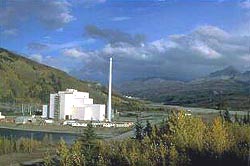|
Is global warming real? Should we all be investing in sunscreen and Bermuda shorts? Will telemarketers soon be calling trying to sell us "vacation properties" in the middle of the Arctic? Or is global warming a sham cooked up by environmentalists who are afraid the warmer temperatures will wreak havoc on their Frozen Tofu Smoothie operations?
In the last Eco-Logical, we presented government data that clearly demonstrates a significant warming pattern and outlined some of the scary potential consequences of this extended warming trend, including lower food production, more damage from storms and floods, and increases in pest-born diseases.
Humanity has built up a large housing, industrial, and agricultural infrastructure in its currently inhabited areas. If the climate does destabilize to make those areas less useable for their current purposes—with the particularly devastating
 effect that crops would no longer grow well where they once did—we will start to see a world of trouble.
effect that crops would no longer grow well where they once did—we will start to see a world of trouble.
What should we do about it? The answer is relatively simple, in theory: Reduce the amount of man-made greenhouse gases—mostly methane, nitrous oxide, halogenated carbons, and carbon dioxide—that we release into the atmosphere. Of these, carbon dioxide is the one that gets the most press since it is the most abundantly released by human processes, particularly the burning of fossil fuels.
In practice, of course, reducing greenhouse gases is not so easy because our industrial economies and our personal activities and comfort have become highly reliant on energy generated by fossil-fuel power plants and petroleum-powered cars, trucks, and SUVs. We obviously can't achieve a 100% solution overnight without causing an unacceptable decline in our way of life.
Some advise delaying implementation of even small changes, claiming that we need more data on global warming and its effects before we should risk any economic harm. But the overwhelming consensus of scientific opinion is that global warming is real, it is man-caused, and it will have troublesome impacts in the future. The longer we delay implementing changes, the deeper we dig the hole.
Because there are a variety of greenhouse gases, there are a variety of solutions that will help reduce global warming. But because carbon dioxide is the most abundant man-made greenhouse gas, the most effective single step we can take is to accelerate our move away from fossil fuels and their impacts. Here are a few ways to encourage this:
- Increase funding for research into ways to cost-effectively use renewable, non-polluting energy sources such as wind, wave, and solar.

- Increase the financial incentives for the development and use of renewable energy and eliminate the tax breaks for fossil-fuel-related activities like oil exploration.
- Increase funding for research into carbon-sequestration schemes and ultimately require them on all remaining power plants using coal, oil, or natural gas.
- Move more quickly to develop a hydrogen-powered vehicle fleet and refueling infrastructure.
The models predict that increases in global average temperatures and the rise in sea level will continue for hundreds of years after stabilization of greenhouse gas concentrations (even if we could immediately freeze concentrations at present levels). But don't fall into the trap of thinking that it's too late to do anything about it, that we're already sunk. It's now more a matter of how MUCH impact global warming will have in the future.
Our action—or inaction—will determine whether we minimize the impact of climate change on the world of our grandchildren and their many generations of children after that, or whether we continue heedlessly on our present course and let the chips fall where they may. Hey, we certainly don't want the climate to change to the point where it's too hot for our tiny loved ones to wear their cute little footy pajamas, do we?!?
|


